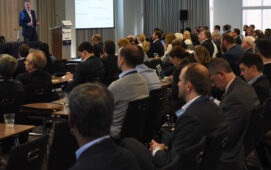Time to take the pulse again, here at SIFMA, to get updated on the status quo, and find out what’s coming next. IntelligentTradingTechnology.com got such insight from Mark Casey, President & CEO at CFN Services.
Q: Compared to a year ago, where are trading firms focusing in their efforts to align latency reduction with their business?
A: Trading firms continue to have a significant focus on latency reduction in the WAN connecting trading venues, but most are taking a more measured approach. There are still some firms that are focused on lowest latency at all costs, but that is balanced by a larger number of firms equally focused on managing the costs and risks associated with investing in ever lower latencies.
Many firms are turning to more optimised means to achieve the best latencies at the best cost. Recognising that most firms are moving the same market data between markets to make trading decisions, trading firms are increasingly migrating to low-latency market data delivery platforms to deliver raw or normalised market data feeds, still at the best latencies, but at considerably lower cost than building out and managing constantly moving latencies and trading venues on dedicated platforms themselves.
Q: What is your company doing to help trading firms reduce latency in a way that benefits their business?
A: One of the traditional ways firms improve latency is by leveraging proximity hosting – essentially decentralising trading decisions. One of the major barriers to this strategy, however, is the cost of acquiring proximity hosting space, then building out and managing a dedicated infrastructure including the low-latency WAN connectivity between markets. CFN Services’ Alpha Platform addresses this challenge head on. By leveraging a flexible and agile platform with leading global WAN latencies interconnecting an ecosystem that includes direct market access, raw and normalised market data, and access to best-of-breed front, middle, and back office trading applications, performance can exceed even some of the best dedicated infrastructures at a tiny fraction of the cost.
Q: Do you think the ‘Low-Latency Arms Race” is over? Or is it entering a new phase?
A: The number of alternatives for low-latency infrastructure to support global securities trading across all asset classes has exploded over the past several years. From improvements in servers and switching, to the fibre, and now wireless networks that connect them, the arms race continues to escalate. A growing base of carriers has entered the low-latency transport market to provide wide area networks connecting key liquidity centers worldwide. In many cases, carriers are deploying brand new networks shaving handfuls of microseconds to multiple milliseconds at costs from several million to several hundreds of millions.
Within this backdrop, we are seeing some evolution. In particular, a clearer segmentation around the top 20 or so firms competing on absolute latency-driving for zero risk arbitrage versus a considerably larger pool of firms leveraging latency as a component of Alpha capture to drive higher profits from a given risk model.
Q: Are your current customers looking to make new investments related to latency over the next year?
A: Yes, most of our clients are looking to make investments in latency anytime they can see a clear ROI. We’re working hard to lower the cost of making latency improvements thus lowering the investment threshold, improving ROI, and expanding the base of firms that can make those investments to improve profitability.
Q: Do you think that regulation (globally) is going to provide opportunities?
A: Yes, the continually-evolving regulatory environment drives considerable complexity for trading firms and opportunities for the service providers that can help simplify that complexity. This is an area we’re keenly focused on. We have a number of initiatives underway to wrap regulatory and compliance solutions around all of the applications running on our Alpha Platform. With security and compliance built in, we can greatly simplify the complexities for our clients, enabling them to spend more time focused on the core of their business.
Q: What are some of the technology developments that your company is leveraging in its offerings?
A: One of the most exciting areas to us is the area of cloud technology. The latest generation of cloud and virtualisation technologies includes the built-in security necessary to support complex regulatory environments, as well as improvements in performance that begin to mirror the capabilities of dedicated servers. We’re leveraging these technologies to lower the barrier to entry for trading performance improvements. We’re deploying these technologies on our Alpha Platform in Chicago, New York, London and Frankfurt, Tokyo, and Singapore – greatly reducing the cost and friction associated with moving trading applications to a proximity environment. The ability for a North American trading firm to spool up a dedicated or virtual server and enable their trading applications within the global equities, options, futures or FX markets has never been better.
Q: Are there technology developments happening that you’re tracking for possible future use in your offerings?
A: We’re following developments around big data – storage and analytics. We’re seeing a rapid evolution across technologies and platforms in this area of data management. We expect to leverage these technologies to help simplify market data management and help our clients cost-effectively address opportunities related to semi-structured and un-structured data.
Q: What is exciting you about the financial markets these days – and how you fit in – right now?
A: There is so much exciting us about the financial markets, from the continued expansion and improvements in electronic markets around the world to the underlying improvements in technologies and cost structures driving them. The financial markets continue to be on the leading edge of most of the technological innovations we see in the broader enterprise IT markets. What’s most exciting for us is figuring out how we can best leverage these developments to benefit our clients.
The top analysts are saying that we’re on the leading-edge of the next major revolution in IT architecture, as fundamental as the shift from mainframe to the client/server. With a global application delivery platform tuned for high-performance trading applications, we’re on the field helping to drive this shift in how trading and technology is done – and that is exciting!
Subscribe to our newsletter




